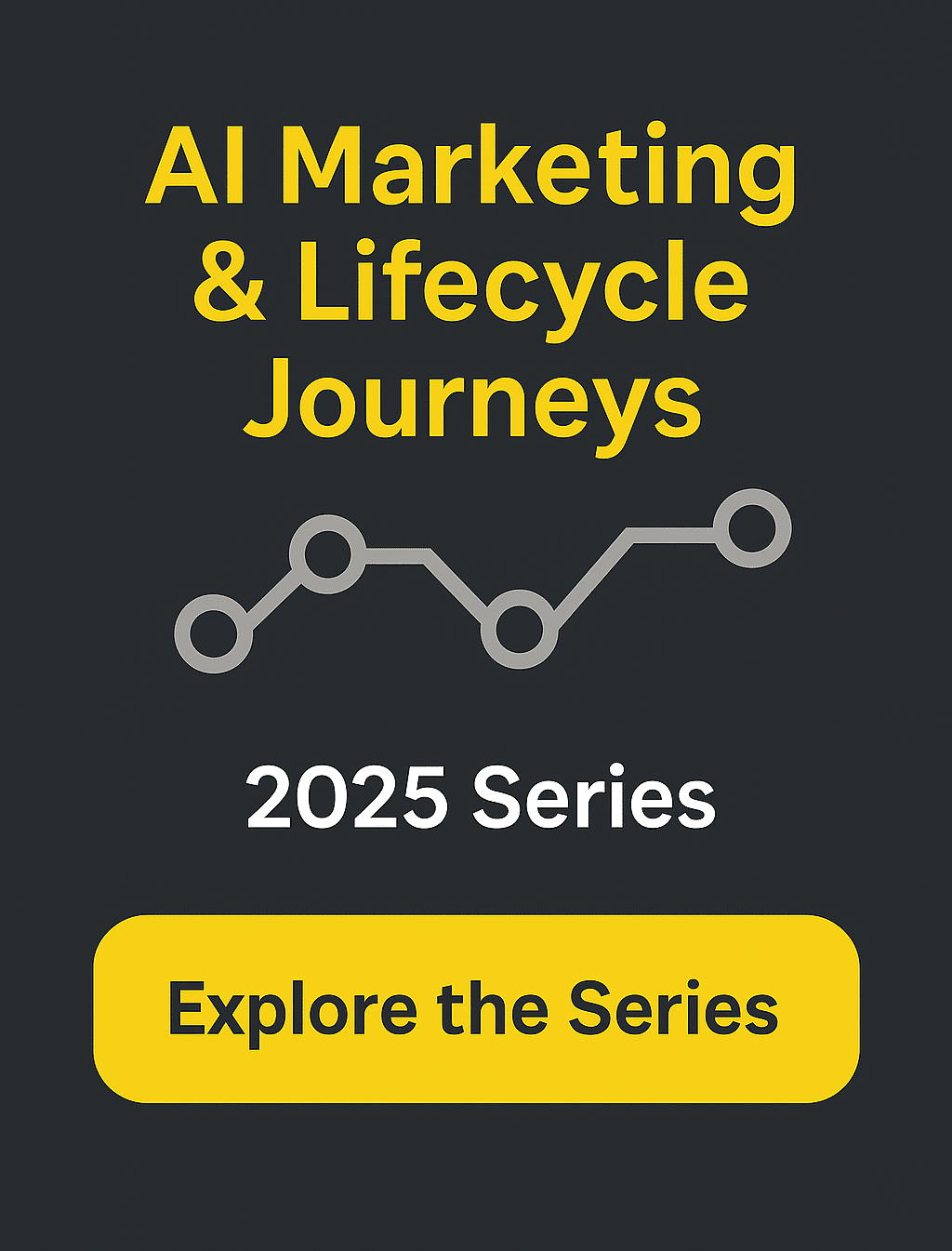⚠️ Work in Progress
These posts are part of an evolving series on AI and lifecycle marketing. I’m in the process of restructuring and expanding them into more digestible segments. If you’re here early, thank you. You’re catching the thinking in motion.
This blog post is part of the AI Marketing & Lifecycle Journeys: 2025 Series. If you’re new here, I recommend starting with my foundational articles on AI-Driven Lifecycle Marketing and Smarter Email Segments with AI.
Today’s consumers expect brands to know them, but without creeping them out. Consumers want relevance, not spam. In fact, 71% expect personalized interactions. Also, 76% feel frustrated when they don’t get them (Stein et al., 2025). For marketers, this is a tough task. They must deliver personalized, 1:1 experiences to customers at every stage of their journey and do it on a large scale.
We’re witnessing a fundamental shift in how personalization works. As third-party cookies fade away and inbox competition increases, companies face new opportunities. The rise of generative AI is changing the game. Now, businesses can turn static campaigns into engaging conversations. Marketers using AI for subject lines and personalized content see great results. They enjoy 26% higher open rates and 41% better click-through rates (Patil, 2024).
This post explores how AI can expand personalization in a way that’s smarter, faster, and infinitely more scalable. And marketers can do this without adding headcount or sacrificing the human touch that builds lasting relationships.
Where We’ve Been: Rule-Based Personalization
Before AI, personalization was often more manual than magical. We relied on rule-based segmentation, rigid customer journeys, and A/B testing that took weeks to yield insights. While effective in small doses, this method hit a wall. It was unable to keep up with the speed and complexity of real customer behavior.
Static segmentation was just that, static. These rules were never designed to evolve in real time or reflect the shifting behaviors of modern consumers. As Potla (2024) noted, “The future of marketing lies in algorithms that don’t just react to customer behavior but anticipate it.”
Most companies view personalization as a mix of separate tactics. However, AI is changing this. It allows for a strategic shift by scaling personalization throughout the entire customer lifecycle (Stein et al., 2025). This move from tactical to strategic personalization sets market leaders apart from followers.
Enter AI: What It Really Means for Lifecycle Marketing
AI in marketing isn’t just about chatbots or clever subject lines. It’s about making your entire lifecycle smarter. AI analyzes behavior, predicts intent, and creates content. Now each customer interaction is a chance for hyper-personalization.
At its core, AI personalization includes:
- Predictive modeling to anticipate behaviors like churn, conversion, or engagement.
- Natural Language Generation (NLG) to write email copy tailored to tone and context.
- Recommender systems to suggest the next best offer or content.
- Behavioral clustering to group users by actual engagement, not assumed personas.
- Adaptive email content that changes at the moment of open based on real-time data.
“To reach consumers where they are and how they want to be met, marketers can embrace two powerful innovations: AI-driven targeted promotions, and the use of gen AI to create and scale highly relevant messages with bespoke tone, imagery, copy, and experiences at high volume and speed.” ~ Stein et al. (2025)
The true power lies in the combination. AI-driven analytics identify exactly who needs what message. Generative AI produces highly personalized content that resonates with each micro-segment. This integration helps marketers create custom experiences on a much larger scale than before.
Scaling Personalization: Use Cases by Lifecycle Stage
Scaling personalization goes beyond automating emails. It involves knowing where your customer is in their journey. Then, you can adjust your messaging to fit their needs. AI helps identify intent and triggers at every stage of the lifecycle. Here’s how AI helps with personalized engagement, from onboarding to retention and more.
a. Onboarding
The welcome moment sets the tone for everything. With AI, you can tailor onboarding emails based on the user’s profile, time zone, or first-click behavior. Predictive analytics helps you choose the best product feature to highlight first. NLG makes sure your tone is perfect, whether it’s upbeat, helpful, or in multiple languages.
Froolik (2024) shows that AI-made onboarding flows, tailored to engagement type and language, boosted retention in multilingual audiences by more than 10%. This multilingual capability is great for global brands moving into new markets. AI helps keep the brand voice while adjusting to local language details.
b. Activation
Getting users to that “aha!” moment is critical. AI helps by identifying friction points and serving personalized content or incentives. Behavioral clustering finds the best user segment. Then, it sends tailored nudges like tips, videos, or special offers. These nudges match the user’s time-to-value stage.
Machine learning algorithms can look at past successful activations. They predict what features or content will engage similar users. This can boost conversion rates by up to 35% (Patil, 2024).
c. Retention
AI-powered retention efforts rely on identifying churn risk before it happens. Algorithms score engagement and purchasing patterns, then trigger tailored win-back flows.
Majka (2024) shows that predictive personalization in CRM systems helps marketers send emotionally-aligned content. This content matches the customer’s mindset before checkout.
A North American retailer used AI for targeted promotions. After three months, they saw a 3% increase in annualized margins (Stein et al., 2025).
d. Re-engagement
When a customer drifts, AI brings them back with more than a “we miss you” email. Tools like dynamic send-time optimization, real-time creative adaptation, and personalized incentives ensure relevance.
Zumstein et al. (2024) argue that “the strength of AI-powered personalization lies not in automating the customer experience, but in adapting it contextually across the journey.” AI-optimized re-engagement emails can recover up to 21% of at-risk customers. This happens through perfectly timed and personalized messages (Patil, 2024).
“the strength of AI-powered personalization lies not in automating the customer experience, but in adapting it contextually across the journey.” ~ Zumstein et al. (2024)
e. Loyalty
Loyal customers deserve more than generic thank-yous. AI calculates lifetime value, then curates perks or referral nudges that feel thoughtful. Advocacy campaigns can start from sentiment analysis or engagement with brand communities.
Anny (2023) notes: “AI-driven personalization enables marketers to move from static campaigns to intelligent, context-aware experiences that evolve with the customer’s journey.”
Email Marketing in an AI-Driven World
Email remains the workhorse of lifecycle marketing—but AI is giving it a serious glow-up. From automated send-time optimization to real-time copywriting, AI is reimagining what’s possible.
Tools like GPT, Phrasee, and Klaviyo use AI to tailor:
- Subject lines and tone
- Call-to-actions
- Visuals and layout
- Send timing
- Language and length
Patil (2024) found that marketers using AI for subject lines and personalized content had 26% more open rates. They also saw a 41% boost in click-through performance. AI-powered content not only performs better; it also evolves. It adapts in real time to each user’s context and behavior.
The European telecom company studied by Stein et al. (2025) deployed AI-enhanced messaging for a handful of campaigns. They saw customers engaging and taking action 10% more often than those who got standard messaging. This significant increase came from the AI’s ability to tailor messages based on age, gender, usage patterns, etc.
The Technology Stack Making It Possible
Behind every AI-powered personalization strategy are the technologies making the magic happen. Platforms like Salesforce, Braze, HubSpot, and Klaviyo are adding AI features. These include predictive lead scoring, automated content blocks, and subject line testing.
A robust framework built on the 5D model (Stein et al., 2025) is essential for successful implementation:
- Data: Unified customer profiles with real-time behavioral data.
- Decisioning: Advanced analytics models for targeting and propensity scoring.
- Design: Central repositories for dynamic content generation and optimization.
- Distribution: Architecture to deliver messages across all customer touchpoints.
- Measurement: Comprehensive analytics to inform ongoing optimization.
You can also build your own workflows using iPaaS solutions (Integration Platform as a Service) like Make.com combined with LLMs like ChatGPT. Froolik (2024) shows how this method helps companies gather data from social media like LinkedIn, Facebook, and Instagram. They can then use this data to create personalized emails at scale, all without needing a multilingual team.
Limitations & Ethics: Building Trust Through Responsible AI
AI isn’t a silver bullet. It can hallucinate, introduce bias, or make predictions that alienate rather than engage. Transparency and consent must be at the core of every personalized experience.
Ethical AI personalization means:
- Explaining why customers see a message.
- Avoiding manipulative dark patterns.
- Being culturally and emotionally sensitive.
- Respecting privacy and consent preferences.
- Building models to validate and govern AI-created content (Stein et al., 2025).
Personalized ads can make people feel intrusive. This happens because the ads become more intrusive (de Groot, 2022, cited in Froolik, 2024). Potla (2024) and Majka (2024) both caution that emotional alignment and trust are the new battlegrounds for loyalty. Trust broken by personalization missteps is hard to recover.
As AI improves at managing sensitive data, strong privacy practices are a must. Transparency and opt-in consent are key, too. These steps help meet regulations like GDPR and CCPA. More importantly, they build customer trust (Patil, 2024).
Conclusion: Personalization at Scale Isn’t a Myth, It’s a Machine
AI has finally given marketers what they dreamed of: personalized experiences that grow without losing quality. You can automate lifecycle emails, customize onboarding, or predict churn. The chances are real and increasing.
Excellence in execution sets leaders apart from followers. As Stein et al. (2025) emphasize, success hinges on seamlessly integrated platforms backed by well-trained teams that can fully maximize investments. To boost performance, focus on efficiency. Get rid of redundant systems and set up strong governance.
Start where you are. Test smartly. Let AI enhance your marketing. It makes your efforts smarter, more personal, and much more scalable.
Stay tuned for my next post on automation! I’ll explore how AI agents and smart workflows are reshaping how we build and manage lifecycle campaigns, without burning out your team.
Works Cited
- Anny, D. (2023). Integrating AI-Driven Personalization in Enterprise Marketing Applications.
- Froolik, A. J. (2024). Effect AI-powered Email Automation: An Analysis of Email Marketing Automation.
- Islam, M. A., et al. (2024). Customer segmentation using machine learning and AI: A systematic literature review.
- Majka, M. (2024). How AI Revolutionizes Customer Relationship Management.
- Patil, D. (2024). Email Marketing with Artificial Intelligence: Enhancing Personalization, Engagement, and Customer Retention.
- Potla, R. T. (2024). AI-Driven Personalization in Marketing Strategies.
- Stein, E., et al. (2025). Unlocking the Next Frontier of Personalized Marketing. McKinsey & Company.
- Zumstein, D., et al. (2024). The Role of AI in Enhancing the Customer Journey.




